As Period I wanes and the Tour de Ski approaches, curiosity is naturally piqued as to how various athletes are analyzing their first four weekends of World Cup racing. In particular, our focus is drawn to Olympic medal hopefuls, like last year’s World Cup Overall Champion Jessie Diggins. How is she feeling as she heads into the holiday break, with two individual and one team sprint podium already under her belt and another six weeks to further sharpen her race gears before the Beijing Winter Games kick off in early February?
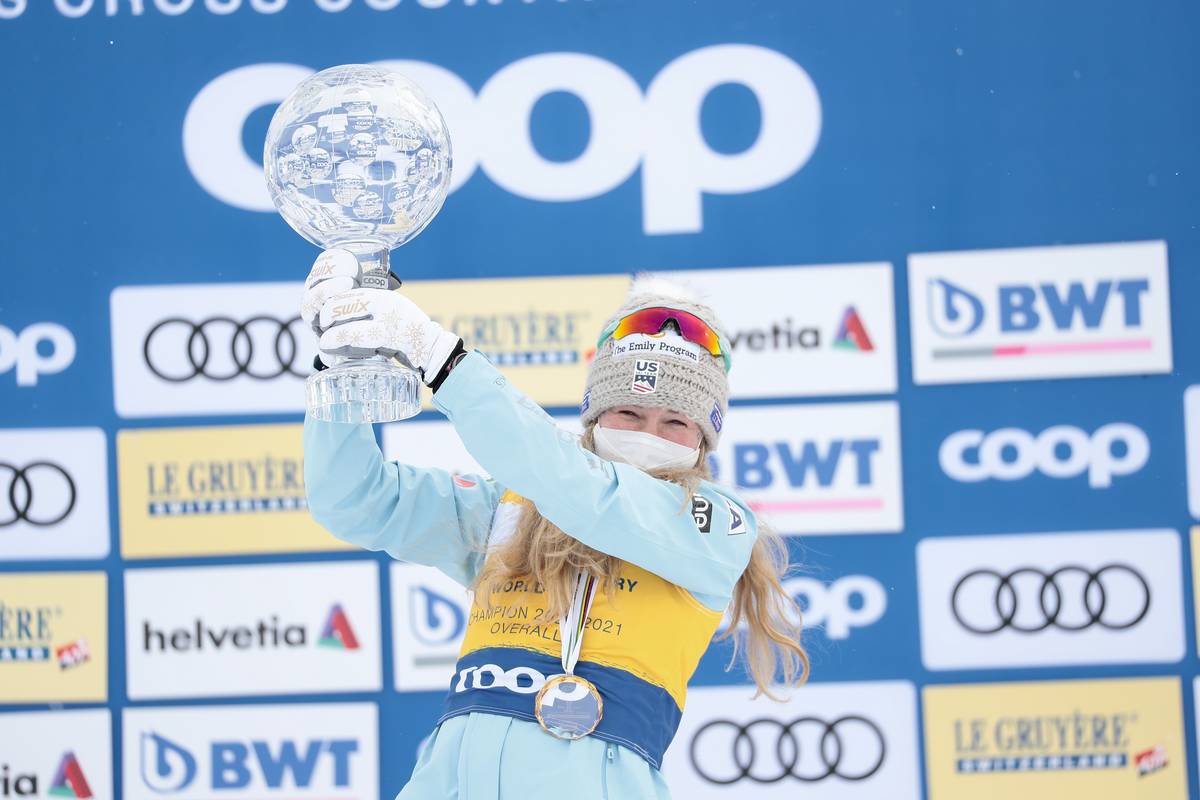
On December 15th, Tom Horrocks, Cross Country Media Coordinator for U.S. Ski & Snowboard, facilitated a Zoom call with a small group of media representatives who wished to question Diggins on the start of her season and her plan for the months ahead. Though we often hear her feelings about individual performances through the audio clips embedded in our race reports, Diggins fielded a variety of broader questions in this call, including her thoughts on early podium finishes, nutritional strategies to support the long grind of World Cup racing, and her focus as the Olympics draw near.
In a previous media call, Diggins explained that viewers should expect her to build into the season as her primary focus was peaking in February for her Olympic goal races. Nevertheless, she won the qualifier in her first World Cup start, the classic sprint in Ruka, then continued to race her way onto the podium on the subsequent three consecutive weekends. If this is what Diggins is capable of while keeping the training volume high in the early season, it’s going to be an entertaining year to be a fan of American cross-country skiing.
“I didn’t have a lot of expectations going into Period I,” Diggins said in the call. “I was not expecting either podium, they came as a wonderful surprise that I’m very grateful for.”
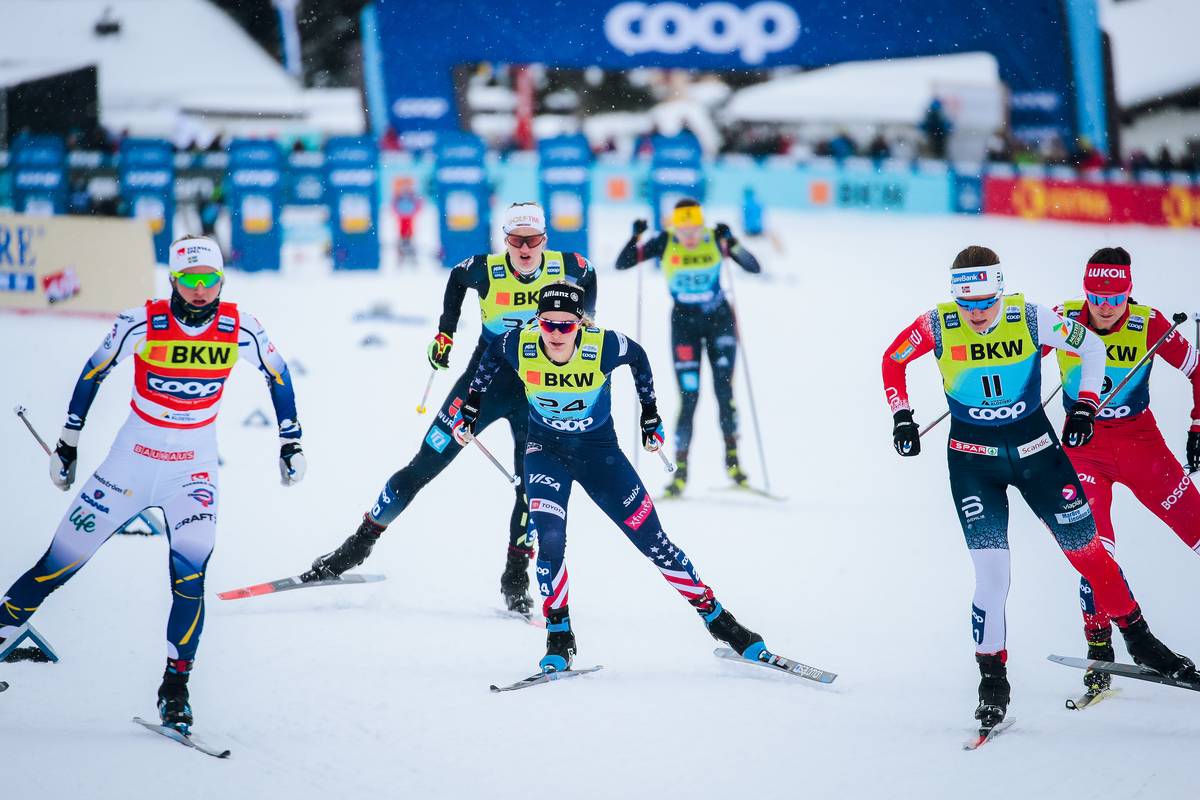
We’ve heard from both Diggins and her coaches that she is an athlete who responds well to frequent racing. While she puts in large volumes of quality work through the summer and fall, it is during the race season that Diggins truly hones her fitness, both physically and mentally.
“Basically, all of this racing is how I get in shape,” Diggins explained. “Because racing that hard gets you in shape pretty fast. So for me, it’s using the Tour de Ski as part of my preparation for the Olympics, but also – whether or not I’m working into the season, whether or not it’s part of the intentional prep phase – for me, every single race I hit it as hard as I can. And as you probably saw in Davos, I crossed the finish line and there was nothing left. And I’m very proud of that, because that’s how my head gets into the exact right space I need it to be in, so that when I am in my sharpest race form at the Olympics, I already know how to push that hard.”
Diggins also fielded a question on balancing her demanding career with ambitious goals with her life outside of skiing, to which she replied:
“To be totally honest, it is my everyday life. There is not as much balance as you might find, as I hope I find in my next job someday when I retire from the sport, a very long time from now. But it is interesting because it is very all-consuming in that everything you do does reflect upon how you race. So you do have to make sure you’re prioritizing taking care of yourself and sleeping enough and hydrating and on your rest day, you don’t want to go climb the nearest mountain, even though it looks incredibly fun, because you have to rest and let your body recover. So I do think that the way I balance it is by having hobbies that are very restful, so it doesn’t take away from my training.”
She explained that earlier that day, she had spent several hours baking a birthday cake for her teammate, Novie McCabe, who had turned 20. She also expressed gratitude for the support of her family and fiancé, Wade, who will be joining her in Davos, SUI for a week at Christmas.
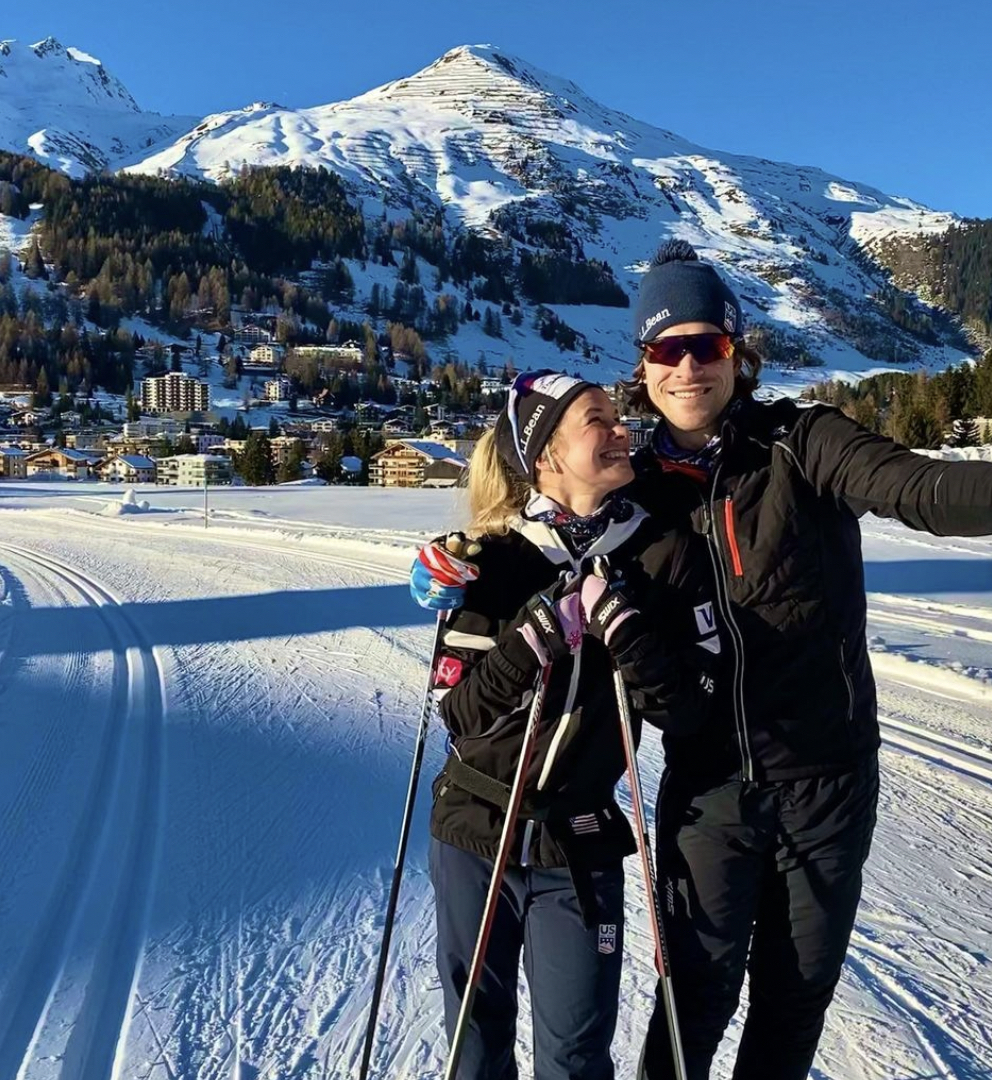
It’s no secret that Diggins has ambitious goals, and she has been open in discussing the work she has put in to manage internal and external expectations and pressures during her career. Particularly in a year where she will receive plenty of attention from the media and her fans as she strives to add additional Olympic medals to her trophy case, she explained how diverting her focus from the end goal allows her to take the steps needed to actually attain it.
“I think it is really important to not fixate on the Olympics, and especially to not fixate on results. Because just thinking about the outcome goals is probably the worst way to achieve them. [That] will create a lot of stress, a lot of pressure and a lot of hype. So, for me, in order to try to meet these big outcome goals, I actually just spend all my time focusing on the process goals and taking care of myself because I really, truly believe that if your mental health is in the right place, that’s how you can push that hard. And that’s how you can train that much and still love it and not feel burned out or feel like racing is suddenly not fun in any way. Because I think, for me anyway, racing does have to be fun in order to be able to push my body that hard over and over and over again.”
A process focus, as Diggins explained, might look like hammering out a specific set of intervals, following a peer and mimicking their technique to fine tune her own, or focusing on skiing the race course in Dresden with powerful leg pushes to maximize her speed on flat terrain.
“It’s really just those little day to day things that add up over time and allow you to get those big goals.”
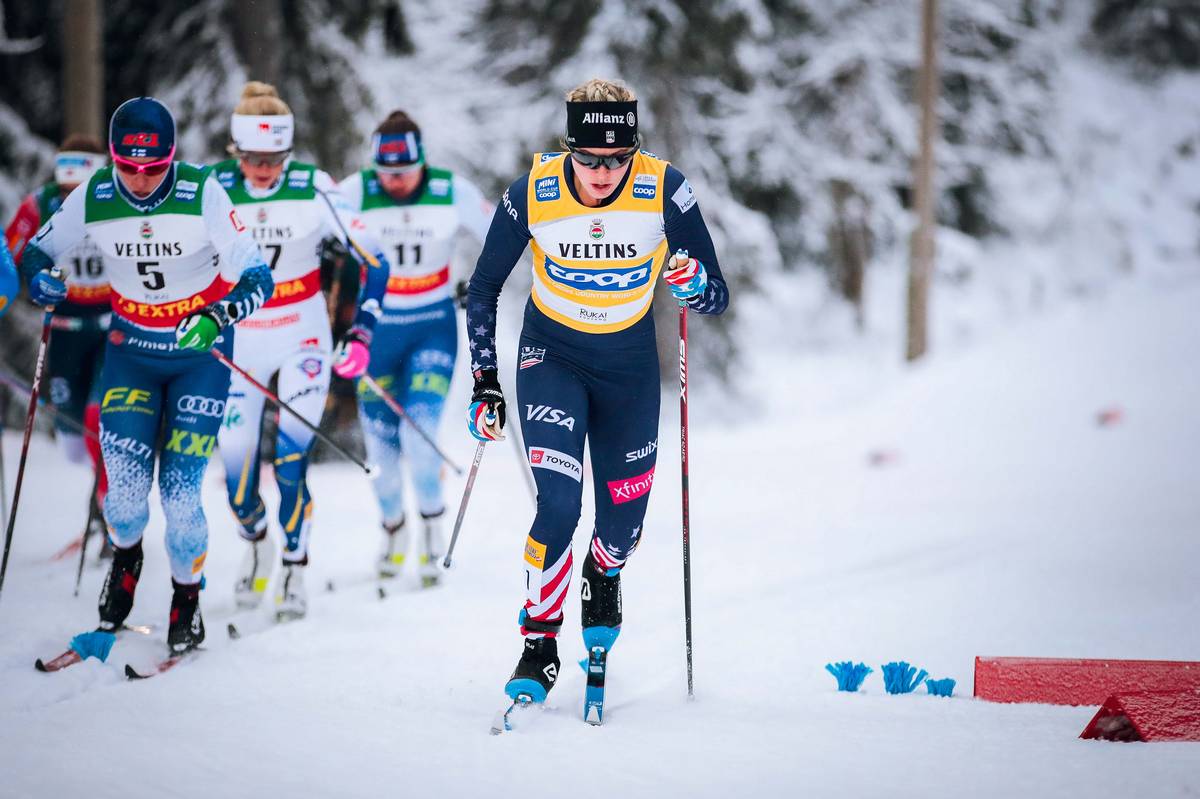
Fielding a question from Peggy Shinn, author of World Class: The Making of the U.S. Women’s Cross Country Team and senior contributor at TeamUSA.org, Diggins discussed the upcoming Olympics and her role in guiding younger teammates through the build up to their first Games as she prepares for her third.
“It’s weird to say your first Olympics, but we are a sport that lends itself to multiple Olympic cycles because of the lifespan of our sport. So your first Olympics is, and should be, incredibly fun, and hopefully, without a lot of pressure. With every resource that you need to succeed, but without the weight of expectations on your shoulders. And so one of the things I’m going to try very, very hard to do is just – ahead of time, answering all the questions about the Olympics that they could possibly have. And also trying to answer questions that they haven’t even thought they might need to ask to prepare them for success in the little things. Like, it might be noisy, so invest in a really good pair of earplugs and an eye mask, and maybe travel with your own pillow – little things that make your room a better setup for rest and recovery. And even, ‘Hey, you know, there’s this athlete Resource Center. You should go print out some pictures of your family and hang them on the wall.’”
She explained how these little touches can go a long way to helping an athlete stay calm and comfortable amidst the wild experience of competing in what our country deems is the pinnacle of sport.
Diggins also spoke highly of the work ethic and grit of her teammates, in particular lauding Julia Kern’s anchor leg in the 4 x 5k relay in Lillehammer, and the contributions of the men who have put at least one American in the semifinals in each sprint event this season.
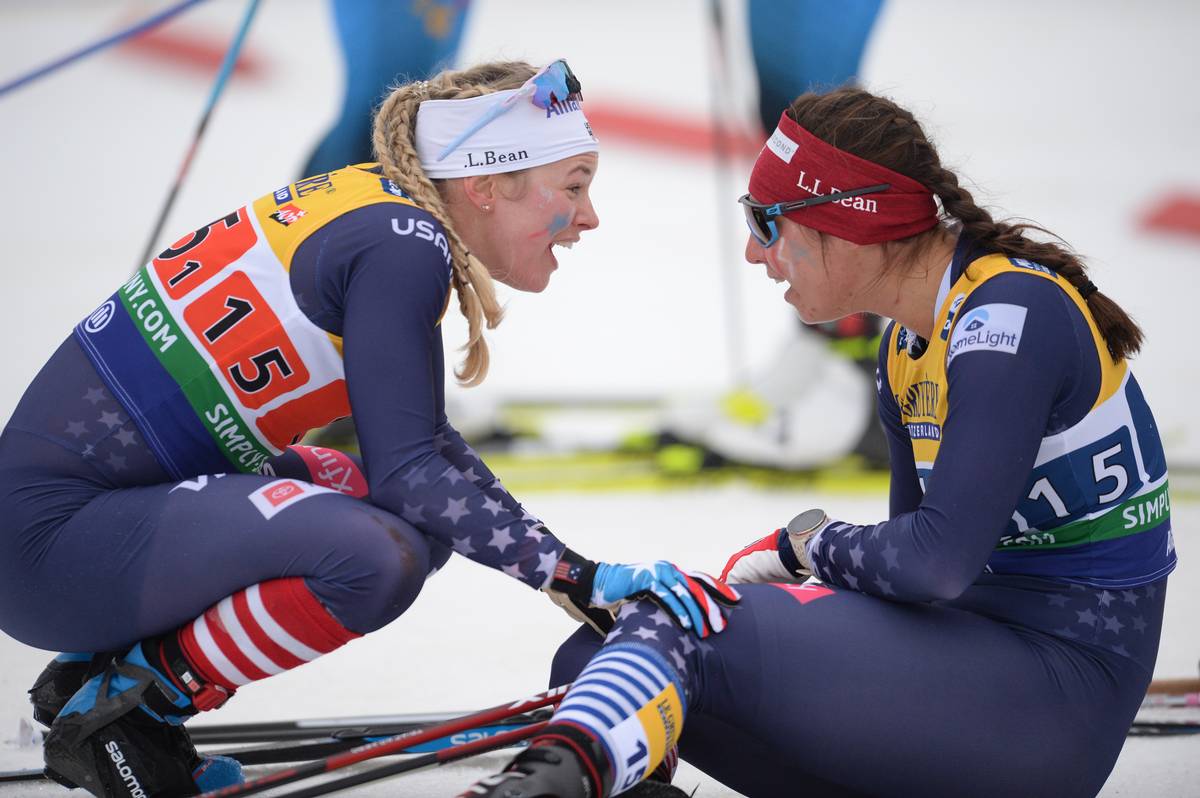
If you’ve listened to interviews with Diggins or follow her on social media, you’ll know she places a high value on teamwork. After a slew of retirements of veteran members of the team, like Sadie Maubet Bjornsen, Sophie Caldwell Hamilton, and Simi Hamilton, Diggins finds herself as the longest standing member of the U.S. Ski Team.
In the most recent episode of Nordic Nation, Gus Schumacher, Ben Ogden, and JC Schoonmaker each recognized Jessie as a mentor who has provided invaluable advice to help them succeed on and off the tracks as they step up to senior level racing on the World Cup. Whether it is support in handling the highs and lows of results, or the tactics required to be in a position to advance during the sprint rounds, they explained that Diggins has been thriving in her unofficial leadership role this season.
Diggins laughed that they may have sung her praises because she had baked them cookies the night before, but then she reflected on her own start on the World Cup and how impactful it was when her older teammates welcomed her into the fold and supported her as she first took her own steps forward in racing.
“I had so many people in my life helping me at my first Olympics,” Diggins recalled. “Obviously, we had Kikkan [Randall], and Liz [Stephen], and Holly [Brooks]. And I was going through my first Olympics, together with Sadie and Ida [Sargent] and Sophie… And on the men’s side, we had Andy [Newell], who had been there before, as well as Simi. It was so cool to feel like I could ask all my questions of them and feel so supported.
“And I also feel like a big part of it, too, is just some of the little things about being on the road. For example, we’re going into the Christmas holiday next week, and for a lot of people it is their first time on the road, away from home for Christmas. And that is hard. You know, I haven’t been home for Christmas in like 10 years. And I remember my first Christmas before the Tour [de Ski]. I was rooming with Holly Brooks. And she was like, ‘All right, no Christmas tears.’ She pulled out a whole bag of cloves and oranges and decorated the room, and we had a big secret Santa with Liz, Kikkan, Holly and me, and it was so cool to feel like they really took me under their wing. They were like, ‘We’re gonna make sure this is fun. We’re gonna make sure that you don’t feel super homesick.’ I feel like around the holidays, or really any hugely emotional time, which includes the Olympics and any Championship – anytime it’s really hard – that’s when you feel like you miss and need your family the most. And that’s when it is so important that the ski team becomes your second family because you need that support to fill those holes.”

Following her 2020 Tour de Ski overall victory, Diggins was interviewed by a sports dietitian on the “Eat for Endurance” podcast. One thing that caught my attention was her discussion of having a dietitian and chef on the road with the team, and how she utilized this resource to combat the inevitable depletion that occurs during an event like the Tour. She explained in the podcast that racing often leaves her stomach unsettled, making it harder for her to replace the calories expended when racing repeatedly at maximal effort in the cold. In order to absorb and translate the efforts of the Tour into a fitness boost for the second half of the World Cup season, she needed to first dig out of a calorie deficit during her post-Tour recovery week, giving her body the energy and nutrients it needed to repair and replenish reserves.
Bringing this approach forward into the upcoming Tour, Diggins explained how important focusing on her nutrition has become to ensure she doesn’t fizzle out by the later stages, or carry fatigue forward into Period III and the Olympics.
“In Tours of the past, I’d found myself getting to the last few stages and just feeling very drained. Which, of course, you will anyway, because it’s very tiring, but you don’t necessarily need to feel drained from an available energy perspective when it comes to food. So it has been really amazing having a dietitian with us during the Tour, because I’m pretty sure the extremely high calorie smoothies actually kept me alive.
“For me, it is interesting because my body manifests stress very physically, even if I don’t feel incredibly stressed – you know, I’m excited to race but not overly fluttery about it. I might feel emotionally like I’m in a great place, but my body’s like, ‘Nah, we’re still stressed.’ And so that makes it very hard to eat enough sometimes.”

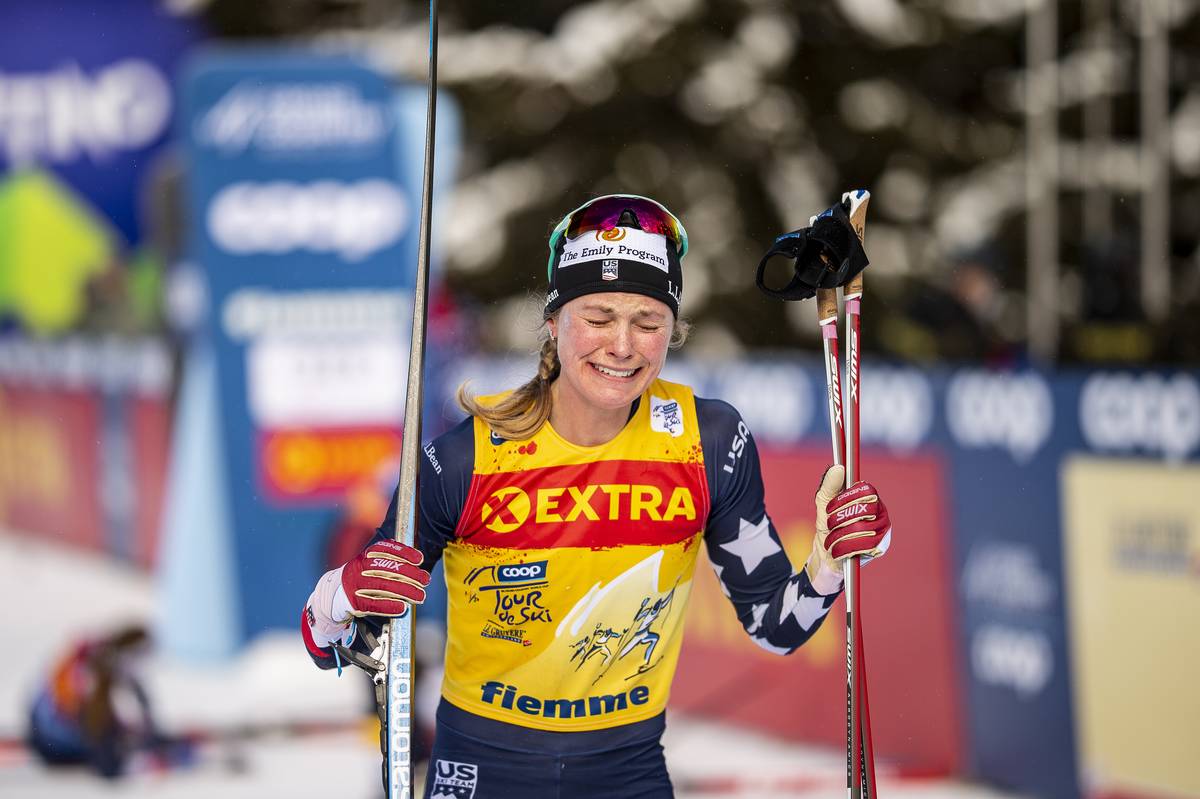
Diggins later explained that one of the ways the stress her body is retaining manifests itself is very visible and “kind of gross.”
“At the last Olympics, the skin just started falling off my hands to the point where I lost my fingerprints on some of my fingers. And it’s weird because – the performance side was great, my best Olympics ever, my headspace was great, the sports psychology was great, I was able to eat enough…”
Nevertheless, Diggins’ body showed clear evidence of the stress that it was under. This leaves Diggins in a catch-22 as she also recognizes the stress of high-stakes racing helps her dig deeper into the well.
“Although I don’t love what [stress] does to my body, I do thrive under that pressure. Instead of making me crack, it just unleashes that very top level of performance and it brings out the best in me. Which is why I think anchoring the relay was, for a very long time, the only way I would have an outstanding World Cup. It took me a very long time to do that individually without the pressure of holding down the team. But yeah, [when my skin started to fall off] I realized, ‘Wow, my body really feels this.’”
Acknowledging that subjecting herself to this level of stress may not be ideal for her long term health, she rationalized that it – so far – has only happened at the Olympics, which only amounts to a three-week period once every four years.
Returning to the concept of mitigating the nutritional losses accrued during the Tour de Ski, Diggins explained some of the principles that the team dietitian has helped her to develop.
“It has been really, really helpful coming up with these strategies. [One of the strategies is] using Nutrimeal in calorie-dense shakes, or stirring it into my oatmeal in the morning. A lot of peanut butter – that stays down and digests really well. And honestly, a lot of chocolate, that helps too, because you always want to eat it, it always tastes good, and you just need the calories however you can get them. So for me, it has been really fun working with the sports dietitian and figuring that out. Then especially after the Tour, it’s been really important to make sure I’m able to absorb everything that I’ve just done, because that is then going into the Olympics.”
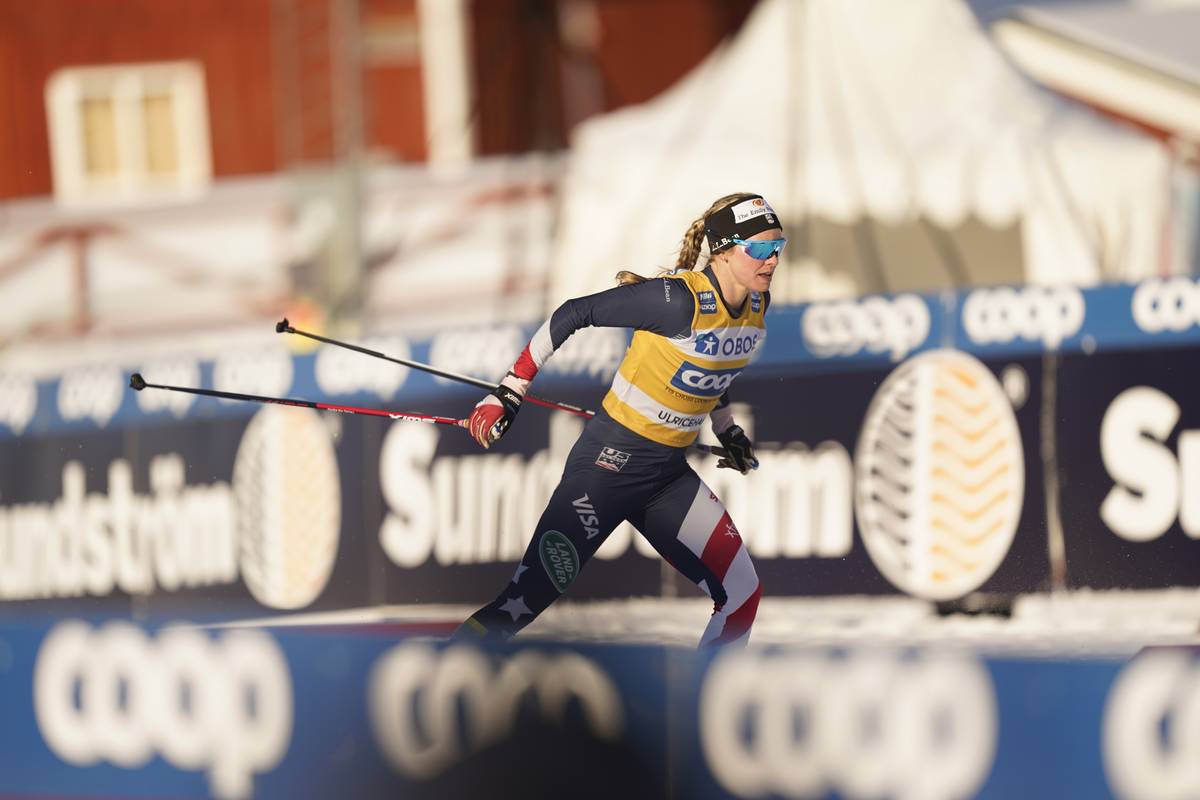
She also explained that she has been working with the dietitian to problem solve fueling throughout the day leading into an afternoon or evening race, like she will encounter in most of her Olympic events. Diggins shared that it’s a fickle balance, ensuring that her body has the energy and fuel throughout the day that it will need to perform come race time, while also making sure her stomach is settled enough that she does not risk revisiting her breakfast or lunch as she pushes herself to her physical limit.
“It’s been really interesting for me working with our amazing staff, and our awesome sports dietitian, to figure out ‘Okay, here’s what you can digest, because you need a lot of calories, it’s going to be very cold, you’re working very hard, you need that energy, but you need to time it in such a way that you will not have an upset stomach.’ You don’t need any distractions on any race day, but especially not at the Olympics.”
Apart from a dietitian, the team often has access to massage and physical therapists. Diggins credits these resources as another invaluable tool in keeping her body healthy.
“We are so fortunate to have this amazing pool of volunteer massage therapists and physical therapists. Having them on the road with us has been absolutely incredible. It’s a good way to avoid injuries before they happen by taking care of those little things that inevitably pop up, but especially during the Tour, you definitely need massage work every single day. I mean, you need even more than that – you need 10 hours of sleep every single day. So I think trying to really stay on top of the body care, the rest of the recovery, the nutrition pieces, the hydration… I travel with a ton of Nuun products, because staying hydrated through all those races, especially sprint days, which are so long, and you inevitably get dehydrated, because it’s hard to drink enough when you’re jumping up and down and your stomach sloshing. For me, trying to take care of those little pieces has been huge. And that’s definitely something that I’ll be talking to our younger and first time Tour team about. ‘Alright, look, it’s gonna be hard to eat enough, it’s gonna be hard to drink enough. But you just really have to keep hammering that home because this is what will get you through the Tour, and then get you through that week after the Tour so you can bounce back and then race well in Les Rousses (FRA).’”

In reviewing Diggins’ last two Olympic appearances, she raced four events in Sochi in 2014 (15k skiathlon, freestyle sprint, 4 x 5k relay, 30k freestyle), and all six events during the 2018 Olympics in PyeongChang, of course, highlighted by her Gold Medal performance in the team sprint with Kikkan Randall.
This begs the question, in her third Olympics, piggybacking on a season where she won the Overall World Cup title and became the first American to win the Tour de Ski, would Diggins take the same approach and stick her neck out in every event with the hope of having a medal placed around it? Or would the approach be more targeted, sitting out in races where perhaps her odds of a medal are lower in order to conserve energy for a few target races?
“I’m definitely one of those athletes that loves to race and to race everything and so I think for me right now, looking at the Olympics, I definitely need to be racing at a level where I’ve earned starts and where it makes sense for me to race the races, but if I’m racing the way I hopefully am when I come into that sharp form, I’d like to race everything for sure. And I think the plan includes racing nearly all the World Cups to get the experience [I need for that], because pacing different courses, different altitudes, and different techniques that does just take time to get all the little things dialed in and play around with them. So the more World Cups I can race, the more I can play around with those little pieces, especially altitude, because that’s when it gets really tricky. So yeah, I think I’ll be racing most things. Probably not every single World Cup this year, but most of them.”
FasterSkier will continue to provide insight into the American team as they continue their individual journeys through this season. If Period I is any indication of what is to come, bringing you this coverage will be a fun job.

Rachel Perkins
Rachel is an endurance sport enthusiast based in the Roaring Fork Valley of Colorado. You can find her cruising around on skinny skis, running in the mountains with her pup, or chasing her toddler (born Oct. 2018). Instagram: @bachrunner4646



